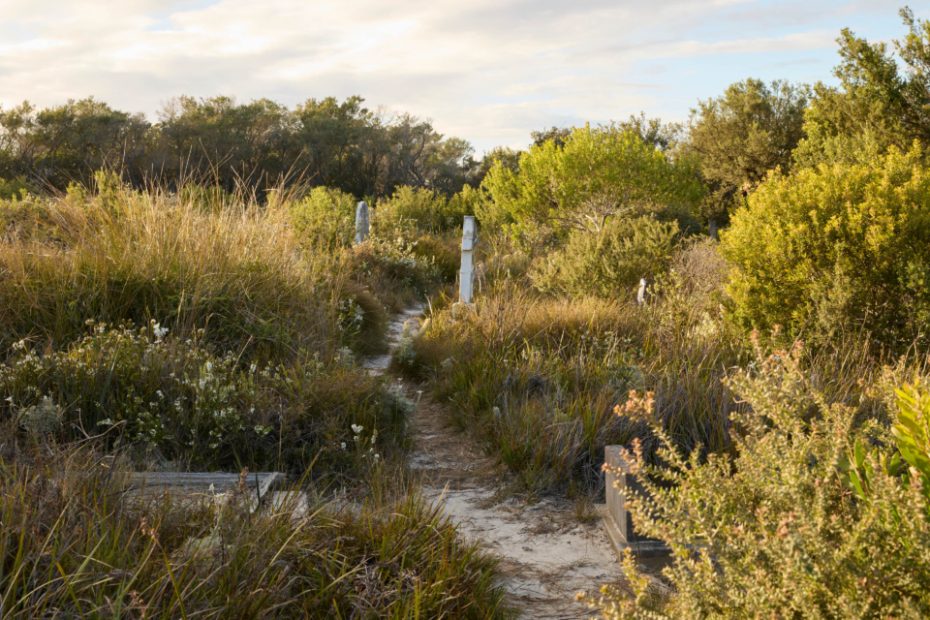Why A Cemetery Is Landscape Designer Robert Champion’s Favourite ‘Garden’
Gardens
Garden designer Robert Champion’s favourite Sydney garden is Third Quarantine Cemetery in Manly.
Robert Champion at Third Quarantine Cemetery.
Aside from one remnant pelargonium (presumably planted by families of the deceased), the plants at Third Quarantine Cemetery are entirely emergent from site,
Built materials are limited to exposed sand paths and the gravestones made from sandstone and marble.
Despite the dark history of Third Quarantine Cemetery where 240 people are buried (most dying from influenza, the bubonic plague, smallpox and scarlet fever), Robert finds the landscape strangely uplifting.
The garden shows environmental damage can be repaired, without erasing cultural history.
The lack of plants above waist height ensures an open and expansive space, allowing visitors to look across its surface to sparkling harbour views and the Sydney city skyline beyond.
North Head Sanctuary Foundation volunteers take care of the cemetery today, preventing the dominance of shrubs that could damage the gravestones.
No matter what time of year you visit Third Quarantine Cemetery, there are at least 10 species in bloom.
Flannel flowers scattered across the site.
The garden is a constant source of inspiration for Robert, who is taking lessons from the cemetery landscape into the National Sculpture Garden Revitalisation project at the National Gallery of Australia in Canberra.
Does Third Quarantine Cemetery qualify as a garden? That depends who you ask.
Some visitors, like garden designer and founder of TARN Robert Champion, are taken with the naturally populated landscape surrounding gravestones dating back to the 1880s, while others debate the design merits of its rambunctious planting.
‘I once overheard public visitors have the following conversation: “It’s very ratty in here; very weedy; not well looked after at all”,’ recalls Robert. ‘It shows how much people’s aesthetic taste and perspective towards gardens can vary.’
Technically, the landscape at Third Quarantine Cemetery isn’t designed — and that’s exactly why Robert loves it.
Aside from one remnant pelargonium (presumably planted by families of the deceased), the plants at Third Quarantine Cemetery are entirely emergent from site, representing the flora of the wider North Head Sanctuary.
‘They are either blown in from the neighbouring bush or have emerged from remnant seed in the soil,’ explains Robert.
Built materials are limited to exposed sand paths and the gravestones made from sandstone and marble.
Despite the dark history of Third Quarantine Cemetery where 240 people are buried (most dying from influenza, the bubonic plague, smallpox and scarlet fever), Robert finds the landscape strangely uplifting.
‘It confirms that deforestation — the land clearance that allowed for the original construction of the cemetery a century ago — is not always permanent,’ he explains. ‘And that we can repair environmental damage, without erasing cultural history.’
North Head Sanctuary Foundation volunteers look after the cemetery today, preventing the dominance of shrubs that could damage the gravestones.
‘This gardening is an act of subtle, gentle subtraction, as opposed to the normal additions of materials, plants, soils and fertiliser. Their careful acts of weeding, pruning and transplanting within the site have made it what it is. But they have not added anything new, aside from their own care,’ says Robert.
‘This editing process actually increases plant diversity when compared to the “nature” that surrounds it, and makes for an incredibly beautiful space.’
The lack of plants above waist height ensures an open and expansive space, allowing visitors to look across its surface to sparkling harbour views and the Sydney city skyline beyond. Sunset is particularly dramatic.
No matter what time of year you visit Third Quarantine Cemetery, there are at least 10 species in bloom. Thick mounds of shrubs provide a continual feast of flowers (grevilleas, wattle, epacrids), ground orchids bloom occasionally, and some years flannel flowers explode across the site in late spring and early summer.
It’s a perennial source of inspiration for Robert, who is taking cues from the site into the National Sculpture Garden Revitalisation project at the National Gallery of Australia in Canberra.
‘I’m drawn to the sculptural quality of the solid, monumental headstones emerging from a rambunctious association of fine-leaved plants,’ says Robert. ‘In principle, it’s analogous to the push and pull of plants and sculptures within the original National Sculpture Garden, albeit in a less artistic way.
‘It also demonstrates that the act of gardening can be responsive to the ‘will’ of the plants, rather than simply imposing a dictatorial control over them.’
Like the dedicated volunteers who tend to Third Quarantine Cemetery, Robert’s vision for Sculpture Garden is to be sensitive, but ambitious, respectfully revitalising, repairing, expanding, overlaying, and connecting the site to Country, ecology, and heritage.
The Design Files is partnering with the National Gallery to bring you stories about Australia’s most beautiful gardens, chosen by the Gallery’s Sculpture Garden Revitalisation project design team. Find out more here.
